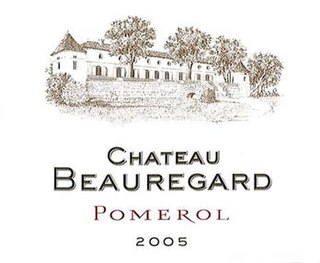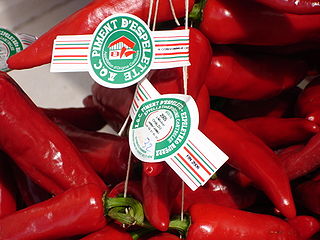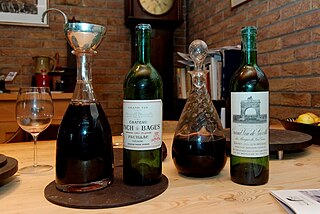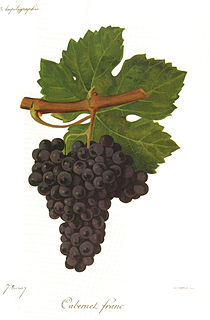Château Brane-Cantenac is a winery in the Margaux appellation of the Bordeaux wine region of France. The wine produced here was classified as one of fifteen Deuxièmes Crus in the original Bordeaux Wine Official Classification of 1855.
Château Marquis d'Alesme Becker is a winery in the Margaux appellation of the Bordeaux wine region of France. The wine produced here was classified as one of fourteen Troisièmes Crus in the historic Bordeaux Wine Official Classification of 1855.

Château Saint-Pierre is a winery in the Saint-Julien appellation of the Bordeaux region of France. The wine produced here was classified as one of ten Quatrièmes Crus Classés in the historic Bordeaux Wine Official Classification of 1855.

Château Grand Corbin-Despagne is a wine from the Saint-Émilion appellation of the Bordeaux wine region of France, ranked a Grand Cru in the Classification of Saint-Émilion wine. The winery is located in the northern part of the Saint-Émilion commune, close to the border of Pomerol.
Vieux Château Certan is a Bordeaux wine from the appellation Pomerol. The winery is located on the Right Bank of the Bordeaux wine region, in the commune of Pomerol in the department Gironde. As all wine produced in this appellation, Vieux Château Certan is unclassified, but the estate is long recognised as among the great growths of the region, and by some reckoned comparable to neighbouring estate Château Pétrus.
Château La Conseillante, previously Château Conseillante and simply La Conseillante, is a Bordeaux wine from the appellation Pomerol. The winery is located on the Right Bank of the Bordeaux wine region, in the commune of Pomerol in the department Gironde. As all wine produced in this appellation, La Conseillante is unclassified, but the estate is estimated among the great growths of the region.
Château Petit-Village is a Bordeaux wine from the appellation Pomerol. The winery is located on the Right Bank of the Bordeaux wine region, in the commune of Pomerol in the department Gironde. As all wine produced in this appellation, Château Petit-Village is unclassified, but the estate is estimated among the great growths of the region.

Château L'Évangile, archaically Fazilleau, is a Bordeaux wine estate from the appellation Pomerol. The winery is located on the Right Bank of the Bordeaux wine region, in the commune of Pomerol in the department Gironde. As all wine produced in this appellation, Château L'Évangile is unclassified, but the estate is estimated among the great growths of the region.

Château Gazin is a Bordeaux wine from the appellation Pomerol. The winery is located on the Right Bank of the Bordeaux wine region, in the commune of Pomerol in the department Gironde. As all wine produced in this appellation, Château Gazin is unclassified, but the estate has since the 1840s been estimated among the great growths of Pomerol.
Château Rouget is a Bordeaux wine from the appellation Pomerol. The winery is located on the Right Bank of the Bordeaux wine region, in the commune of Pomerol in the department Gironde. As all wine produced in this appellation, Château Rouget is unclassified but the estate has been historically estimated among the great growths of the region. Rouget is situated adjacent to Château La Croix-de-Gay.
Château Lafleur is a Bordeaux wine from the appellation Pomerol. The winery is located on the Right Bank of the Bordeaux wine region, in the commune of Pomerol in the department Gironde. As all wine produced in this appellation, Château Lafleur is unclassified, but the estate is estimated among the great growths of the region. Among the most rare and expensive wines, the wine is widely cited as one of the world's finest.
Château Trotanoy, archaically Trop Ennuie, is a Bordeaux wine from the appellation Pomerol. The winery is located on the Right Bank of the Bordeaux wine region, in the commune of Pomerol in the department Gironde. As all wine produced in this appellation, Château Trotanoy is unclassified, but the estate is estimated among the great growths of the region.
Château Feytit-Clinet is a Bordeaux wine from the appellation Pomerol. The winery is located on the Right Bank of the Bordeaux wine region, in the commune of Pomerol in the department Gironde. As all wine produced in this appellation, Château Feytit-Clinet is unclassified, but the estate is estimated among the great growths of the region.
Château Certan de May, fully named Château Certan de May de Certan, is a Bordeaux wine from the appellation Pomerol. The winery is located on the Right Bank of the Bordeaux wine region, in the commune of Pomerol in the department Gironde. As all wine produced in this appellation, Château Certan de May is unclassified but the estate is long estimated among the great growths of the region.

Château Beauregard is a Bordeaux wine estate from the appellation Pomerol. The winery is located on the Right Bank of the Bordeaux wine region, in the commune of Pomerol in the department Gironde. As all wine produced in this appellation, Château Beauregard is unclassified but the estate is estimated among the great growths of the region.
Château Mazeyres is a Bordeaux wine from the appellation Pomerol. The winery is located on the Right Bank of the Bordeaux wine region, in the commune of Pomerol in the department Gironde. As all wine produced in this appellation, Château Mazeyres is unclassified but the estate is estimated among the great growths of the region.
Château La Fleur-Pétrus is a Bordeaux wine from the appellation Pomerol. The winery is located on the Right Bank of the Bordeaux wine region, in the commune of Pomerol in the department Gironde. As all wine produced in this appellation, La Fleur-Pétrus is unclassified but the estate is estimated among the great growths of the region.
Château Hosanna, formerly Château Certan-Giraud, is a Bordeaux wine from the appellation Pomerol. The winery is located on the Right Bank of the Bordeaux wine region, in the commune of Pomerol in the department Gironde. As all wine produced in this appellation, Château Hosanna is unclassified, but Certan-Giraud has historically been estimated among the great crus of the region.
Château Latour à Pomerol is a Bordeaux wine from the appellation Pomerol. The winery is located on the Right Bank of the Bordeaux wine region, in the commune of Pomerol in the department Gironde. As all wine produced in this appellation, Château Latour à Pomerol is unclassified, but is estimated among the great crus of the region.
Château La Tour de Mons, archaically named Tour de Marsac, is a winery and wine from the appellation Margaux, located in the Left Bank of the Bordeaux wine region of France, in the commune of Soussans. The wine was rated Cru Supérieur in the Cru Bourgeois classification of 1932, and through later revisions until the temporary annulment of the classification in 2007.












